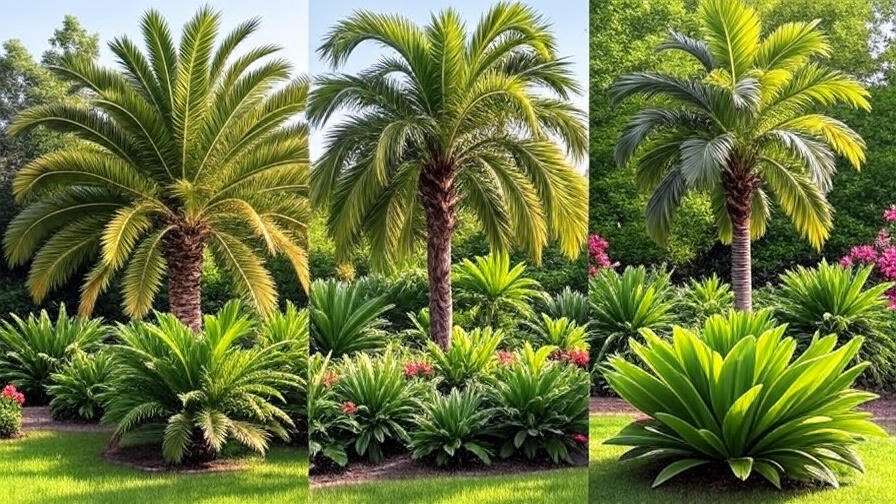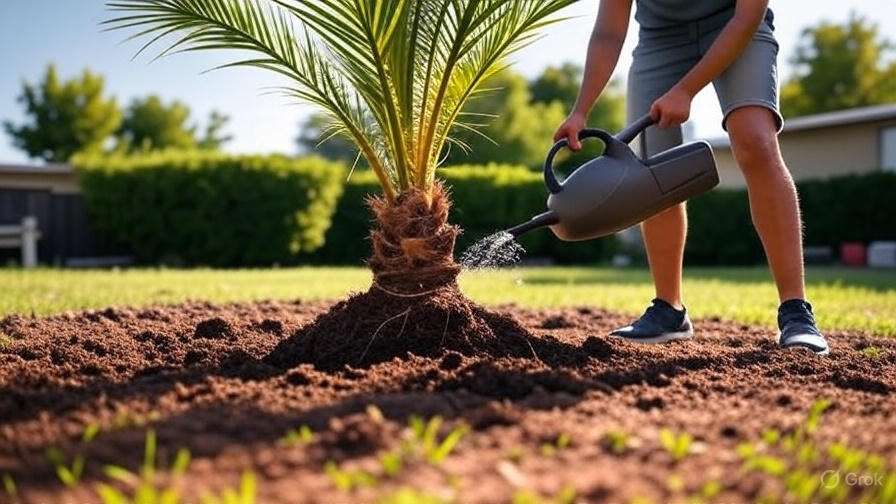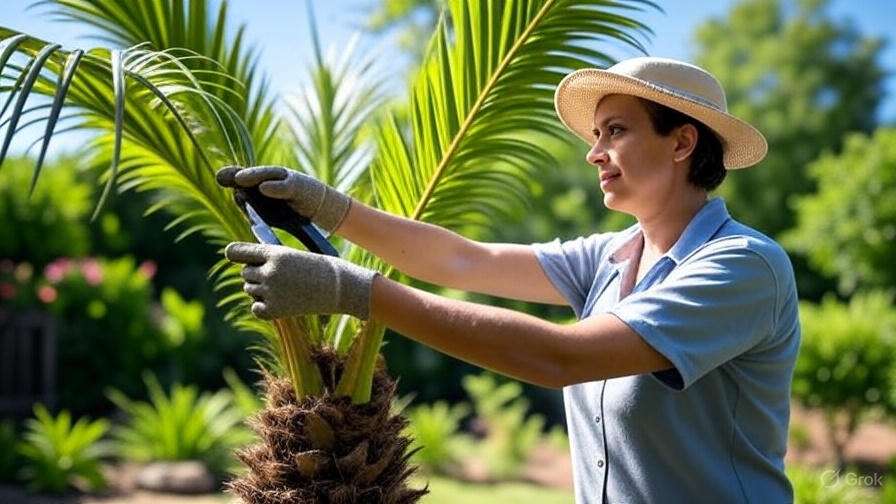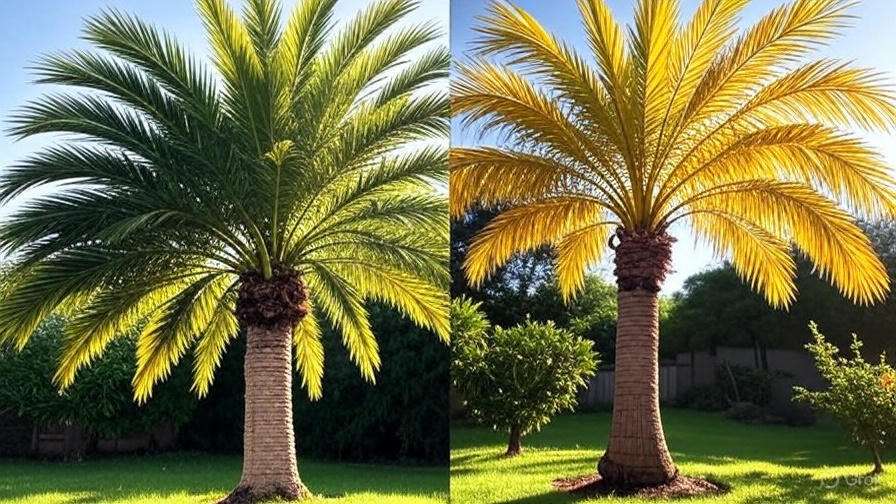
Outdoor Palm Trees: The Ultimate Guide to Choosing, Planting, and Caring for Palms in Your Garden
Imagine stepping into your garden and being greeted by the graceful, tropical beauty of outdoor palm trees 
In this ultimate guide, we’ll walk you through everything you need to know about outdoor palm trees—from selecting the right species for your garden to planting and maintaining them for years of beauty. Whether you’re a gardening beginner or looking to expand your outdoor space with palm trees, we’ve got you covered. Let’s dive in and make your garden the tropical paradise you’ve always dreamed of!
Table of Contents
ToggleWhat Are Outdoor Palm Trees?
Outdoor palm trees are a stunning addition to any garden or landscape, offering a tropical flair and an easy way to create a relaxed, vacation-like atmosphere. 
Palm trees are unique in their appearance, with long, slender trunks and lush, fan-like or feather-like leaves. They come in various types, each suited for different climates and gardening needs. 
Palm trees also come in a range of sizes, from small varieties that are perfect for smaller spaces to tall, majestic trees that can make a bold statement in larger landscapes. Whether you’re working with a small backyard or a spacious garden, there’s a palm tree to suit your needs.
In addition to their beauty, outdoor palm trees are generally low-maintenance, making them a great choice for both beginner and seasoned gardeners. With the right care, they can thrive for many years, providing shade, privacy, and visual appeal.
Ready to bring some palm paradise to your garden? Keep reading to discover which outdoor palm tree varieties are best for your space and climate, plus expert tips for planting and care!

Best Outdoor Palm Trees for Your Garden 
When selecting outdoor palm trees for your garden, the key is choosing species that thrive in your local climate and fit your space. Palms can transform your garden into a tropical paradise, but not all palms are suited for every environment. Here’s a guide to the best outdoor palm trees that can elevate your garden’s look with minimal effort.
1. Areca Palm (Dypsis lutescens) 
Known for its feathery, arching fronds, the Areca Palm is perfect for tropical and subtropical gardens. It’s relatively low maintenance and grows best in full sun to partial shade. Make sure it’s planted in well-drained soil to avoid waterlogging.
Best for: Low-maintenance garden design with tropical vibes.
2. Sago Palm (Cycas revoluta) 
While technically not a true palm, the Sago Palm is a popular choice for outdoor spaces. Its stiff, glossy leaves and compact size make it great for smaller gardens or container planting. Sago palms love the sun but can tolerate some shade too. Just remember, they prefer dry conditions once established.
Best for: Smaller gardens or containers, adding structure and elegance.
3. Windmill Palm (Trachycarpus fortunei) 
If you live in a colder climate, the Windmill Palm is your go-to option. This hardy palm can withstand temperatures as low as 10°F (-12°C) and still thrive. With its fan-like fronds and clean trunk, it’s an ideal palm for year-round interest in cooler regions.
Best for: Cold climates, providing a tropical look in any season.
4. Foxtail Palm (Wodyetia bifurcata) 
The Foxtail Palm is well-loved for its bushy, feathery fronds that resemble a fox’s tail. It’s relatively fast-growing and makes a statement as a focal point in any garden. Preferring full sun, it can tolerate various soil types as long as it’s well-drained.
Best for: Statement trees in sunny gardens with space for growth.
5. Kentia Palm (Howea forsteriana) 
Kentia Palms are elegant and easy to grow, making them perfect for gardeners who want a tropical touch with minimal effort. They’re adaptable to a variety of lighting conditions, from partial shade to full sun. These palms can reach heights of 10 to 12 feet, adding a touch of grandeur to any garden.
Best for: Low-light spaces and medium-sized gardens.
6. Queen Palm (Syagrus romanzoffiana) 
The Queen Palm is a classic beauty with graceful, arching fronds and a smooth trunk. It thrives in sunny, warm climates and can grow up to 40 feet tall. If you’re looking for a tall, elegant palm, this one will make a stunning addition to your garden.
Best for: Large gardens or landscapes, where height and elegance are key.
7. Pygmy Date Palm (Phoenix roebelenii) 
If you’re short on space but still want the beauty of a palm, the Pygmy Date Palm is an excellent choice. This compact palm only grows up to 6-10 feet, making it ideal for smaller gardens or even patios. It enjoys full sun to partial shade and is drought-tolerant once established.
Best for: Small gardens, patios, or container planting.
Quick Tips for Palm Tree Success 
- Sun Exposure: Most palms prefer full sun or partial shade. Be sure to check the specific light needs of each species.
- Watering: While palms like regular watering, they do not thrive in soggy soil. Ensure good drainage to prevent root rot.
- Soil: Well-drained soil is crucial. Palms typically prefer slightly acidic to neutral soil.
- Temperature: Some palms are cold-hardy, while others thrive only in warmer climates. Always choose palms suited for your region’s climate.
By selecting the right palm for your garden, you can create a beautiful, low-maintenance landscape that thrives year-round.

How to Plant Outdoor Palm Trees 
Planting outdoor palm trees can transform your garden into a tropical paradise. Whether you’re aiming to enhance your backyard’s curb appeal or create a peaceful, relaxing environment, palm trees are a fantastic choice. Here’s a simple, step-by-step guide to help you plant and care for your outdoor palms with ease.
1. Choose the Right Palm Variety 
Before planting, it’s essential to pick a palm that suits your climate and space. Popular outdoor palm varieties include the Areca Palm, Royal Palm, and Sago Palm. Research the specific needs of the palm you’re selecting, as some are better suited to tropical climates, while others can tolerate cooler temperatures.
2. Select the Perfect Location 
Palm trees thrive in sunny spots with well-drained soil. Find a location that gets at least 6 hours of direct sunlight each day. Avoid planting near buildings, fences, or other trees that could shade the palm or restrict its growth. Also, consider the mature size of your palm tree—ensure there’s enough space for it to grow tall and wide.
3. Prepare the Soil for Planting 
Palms prefer well-drained, sandy soil. If your soil is heavy or clay-like, amend it with organic compost or sand to improve drainage. Dig a hole that is about twice the size of the root ball of your palm. This gives the roots plenty of room to spread out and establish a strong foundation.
4. Planting the Palm 
- Place the palm in the center of the hole, making sure the top of the root ball is level with the surrounding soil.
- Gently fill in around the root ball with the amended soil. Avoid packing the soil too tightly—palm roots need some air to grow.
- Water the plant immediately after planting to settle the soil and remove any air pockets.
5. Watering and Mulching 
Palm trees need consistent moisture to establish themselves, especially in the first year. Water regularly but avoid overwatering, as palms are sensitive to root rot. Apply mulch around the base of the tree to retain moisture, keep the soil cool, and reduce weed growth. Ensure the mulch doesn’t touch the trunk to prevent rot.
6. Fertilizing for Growth 
Feed your palm tree with a slow-release, balanced fertilizer designed for palms. Fertilize in the spring when the tree starts showing signs of new growth, and again in mid-summer. Be sure to follow the manufacturer’s instructions for the right amount and frequency.
7. Maintenance and Care 
As your palm tree grows, keep an eye out for any dead or damaged fronds. Trim them carefully to maintain the tree’s shape and health. Also, check for pests like scale insects or mealybugs, which can affect palm health. Regularly watering and fertilizing your palm will help it thrive year-round.
8. Protecting Your Palm in Winter 
If you live in a region with cold winters, protect your palm tree by wrapping it in burlap or using a frost blanket during extreme cold spells. Palms are sensitive to frost, so this extra care will help them survive the colder months.
By following these simple steps, you can successfully plant and nurture a beautiful palm tree in your garden, adding a touch of tropical elegance to your outdoor space.

Care Tips for Healthy Outdoor Palm Trees 
Outdoor palm trees are a beautiful addition to any garden, but keeping them healthy requires proper care. Here are some expert tips to help your palms thrive:
1. Choose the Right Location 
Palm trees love sunlight! Make sure you plant them in a spot that gets full sun for at least 6-8 hours a day. However, some palms, like the Kentia Palm, can tolerate a bit of shade, so always check the specific needs of your palm variety.
2. Watering: Don’t Overdo It 
Palms prefer moist soil but hate being waterlogged. Water deeply but infrequently, letting the soil dry out between waterings. During hot summer months, increase watering, but in winter, reduce it to avoid root rot. A good rule of thumb is to water when the top 2-3 inches of soil feel dry to the touch.
3. Proper Drainage is Key 
Ensure your palm is planted in well-draining soil or in a raised bed if you live in an area with heavy rainfall. Palms are sensitive to “wet feet,” and stagnant water can lead to root rot.
4. Fertilize Regularly, but Not Too Much 
Fertilizing your palm tree is essential for growth, but don’t go overboard. Use a slow-release, balanced fertilizer designed for palms 2-3 times a year—typically in early spring and summer. Be cautious of over-fertilizing, as this can burn the roots and stunt growth.
5. Prune Dead Fronds Carefully 
Palm fronds naturally die off as the tree matures. Only prune the dead or brown fronds, and avoid cutting the green, healthy ones, as these are vital for photosynthesis. Use clean, sharp tools to prevent damage to the tree.
6. Protect from Cold Weather 
Most palms aren’t frost-resistant. If you live in an area where temperatures drop below freezing, protect your palms by wrapping them in burlap or covering them with a frost cloth. You can also use mulch around the base to insulate the roots.
7. Watch for Pests and Diseases 
Common pests like scale insects, spider mites, and mealybugs can damage your palm tree. Regularly inspect your palms for signs of infestation, such as yellowing or browning leaves. Treat with organic insecticides or neem oil as needed. Additionally, watch for fungal infections and trim affected areas immediately.
8. Repot if Needed 
If your palm is in a pot, it might outgrow its container. Repot your palm every 2-3 years to give it room to grow. Choose a pot that’s just 2-3 inches larger than the current one to avoid overwatering issues.
9. Add Mulch for Moisture Retention 
Applying a layer of mulch around the base of your palm can help retain moisture, regulate soil temperature, and prevent weeds. Just make sure not to pile mulch against the trunk to avoid rot.
With these simple care tips, your outdoor palm trees will stay healthy and vibrant, creating a tropical oasis in your garden for years to come!

Troubleshooting: Common Problems with Outdoor Palm Trees
Taking care of outdoor palm trees can be incredibly rewarding, but even seasoned gardeners encounter problems along the way. Fortunately, many issues can be fixed with a little attention and the right care. Here’s how to solve some of the most common problems you’ll face with your palm trees 
1. Yellowing Leaves
Yellowing leaves are a sign that your palm may be stressed, often due to a nutrient imbalance or improper watering.
- Solution: If the yellowing is occurring on older leaves, it’s usually natural. However, if new leaves are affected, check for a potassium deficiency. Apply a balanced fertilizer with micronutrients like magnesium and iron. Also, ensure you’re not overwatering, as soggy soil can lead to root rot
.
2. Brown Tips on Leaves
Brown tips are often a sign of underwatering or low humidity. Palm trees thrive in humid environments, so when the air is too dry, their leaves suffer.
- Solution: Increase humidity by misting the leaves or placing a humidity tray nearby. If the soil feels dry, water the palm deeply, ensuring the roots get adequate moisture. Consider moving the plant to a slightly more humid location or use a humidifier if indoors
.
3. Pests and Insects
Outdoor palm trees can be prone to pests like spider mites, scale insects, and aphids, which can damage the leaves and affect the overall health of the plant.
- Solution: Inspect the leaves regularly for signs of pests. If you find any, treat the palm with insecticidal soap or neem oil. For a more natural remedy, a strong blast of water from a hose can remove many pests from the surface of the leaves. Keep the area around your palm tree free from fallen debris to avoid attracting bugs
.
4. Wilting or Drooping Leaves
Wilting or drooping leaves can be a result of overwatering, underwatering, or a lack of sunlight. Palms need consistent care to thrive, and inconsistent watering can confuse them.
- Solution: Ensure you’re watering your palm consistently, allowing the soil to dry out between waterings. A soil moisture meter can help you monitor the moisture levels and avoid underwatering. Also, make sure your palm is receiving enough sunlight—palm trees need bright, indirect light for optimal growth
.
5. Stunted Growth
If your palm tree isn’t growing as it should, it might be suffering from poor soil conditions, insufficient nutrients, or even a container that’s too small (if it’s potted).
- Solution: Reassess your palm’s soil and nutrients. Use a slow-release fertilizer designed for palms and make sure the soil drains well. If your palm is in a pot, consider repotting it into a larger container with good drainage. Ensure it’s getting enough light and water to support growth
.
6. Root Rot
Root rot is one of the most common causes of palm tree decline, especially if you’ve been overwatering or the tree is in poorly-draining soil.
- Solution: Check the roots by gently removing the palm from its pot (if applicable). If the roots are dark, mushy, or smell bad, trim off the affected areas and repot the palm in fresh, well-draining soil. In outdoor settings, make sure the planting hole has proper drainage to prevent water from pooling around the roots
.
7. Leaves Turning Brown at the Base
If the base of the leaves turns brown or the edges of new fronds start to wither, this could be a sign of a fungal infection or poor air circulation.
- Solution: Trim any affected leaves to stop the spread of the infection. Consider using a fungicide to treat any mold or mildew problems. Ensuring proper air circulation around the palm can also prevent these types of issues. Avoid overcrowding your garden to give your palm room to breathe
.
By identifying and addressing these common issues early, you can ensure your palm tree stays healthy and continues to thrive in your garden 

Conclusion 
Outdoor palm trees are a beautiful and low-maintenance addition to any garden, offering a touch of tropical elegance and transforming your outdoor space into a serene paradise. Whether you’re looking to enhance your garden with a hardy palm for cooler climates or a sun-loving variety for warmer areas, choosing the right palm and following proper care guidelines ensures long-term success.

With the tips provided in this guide—from selecting the perfect variety to mastering planting and maintenance techniques—you’re now equipped to grow and care for your outdoor palm trees with confidence. So, why wait? Start your palm-growing journey today and enjoy the stunning beauty and tranquility they bring to your garden!
Frequently Asked Questions(FAQ)
How much sunlight do outdoor palm trees need?
Outdoor palm trees typically thrive in bright, indirect sunlight. However, some varieties like the Windmill Palm can tolerate partial shade, while others, like the Mexican Fan Palm, prefer full sun. Be sure to match the light requirements of the specific palm with the conditions in your garden.
Can outdoor palm trees grow in cold climates?
Yes, some outdoor palm trees, such as the Windmill Palm and Needle Palm, are cold-hardy and can withstand temperatures as low as 10°F (-12°C). However, most palm species prefer warmer climates, so it’s essential to choose a variety suited to your region’s climate.
How do I plant outdoor palm trees in my garden?
To plant outdoor palm trees, dig a hole twice the size of the root ball, ensuring good drainage. Use well-draining soil, and place the palm tree in the hole, filling it with soil and gently watering it. Space palms according to their mature size for optimal growth.
How often should I water my outdoor palm trees?
Outdoor palm trees need regular watering, especially in dry periods, but ensure the soil has proper drainage. Water when the top inch of soil feels dry, but avoid letting the plant sit in water as this can cause root rot. During the winter months, reduce watering as the plant enters a dormant phase.
What type of fertilizer should I use for outdoor palm trees?
Use a slow-release, balanced fertilizer that is specifically designed for palm trees. Apply the fertilizer during the growing season (spring and summer) every 6 to 8 weeks. Avoid fertilizing in the fall or winter when the palm’s growth slows down.
Can I grow outdoor palm trees in containers?
Yes, many small outdoor palm trees, such as the Pygmy Date Palm, can thrive in containers. Ensure the container is large enough with proper drainage and use a well-draining potting mix. Regularly check for root-bound palms and report them when needed.
How do I protect outdoor palm trees during winter?
For frost-sensitive palms, protect them during winter by covering them with frost cloth or burlap. In extremely cold climates, consider bringing potted palms indoors or placing them in a sheltered location. You can also mulch around the base to help retain warmth in the soil.
What are common pests for outdoor palm trees and how can I control them?
Common pests include spider mites, mealybugs, and scale insects. To control them, inspect your palm regularly and remove pests manually. For heavier infestations, use insecticidal soap or neem oil as natural, non-toxic treatment options.


